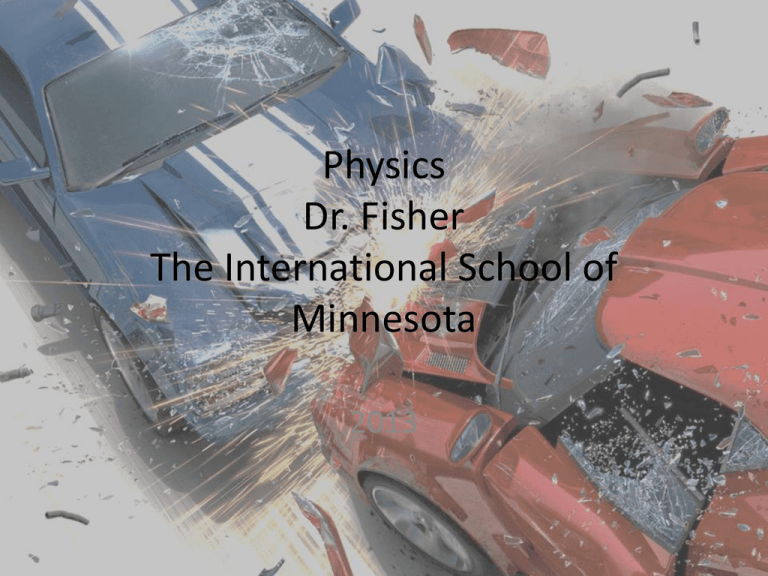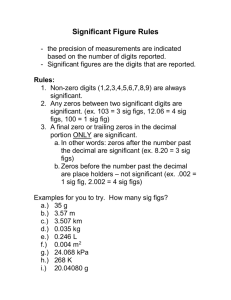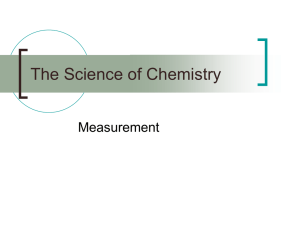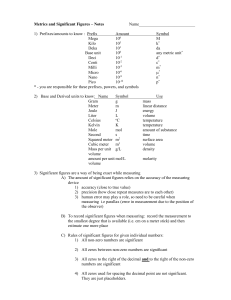Chapter 1 class presentation-1
advertisement

Physics Dr. Fisher The International School of Minnesota 2013 …about me • Farm boy from central Iowa: cattle, hogs, corn, soybeans, alfalfa, brothers, machinery, outdoors, sports, school, drama, music, JETS • BS Chemical engineering Iowa State, 3M, pilot • MS biomedical engineering, campus politics • PhD (Bio)chemical engineering Iowa State (minor in Technology and Social Change) • Prof at U. of Washington (Seattle) in Chem Engr • Research engineer and scientist and manager at Cargill Inc., fermentation technology, separations, Brussels • Married, kids, bees, hobbies, rants, likes, dreams…… Some class logistics • Course overview: handout (lots of info!) • Name on book! • Ismscience.org – Subscribe to get updates – Check weekly – Check before you sit to do HW (might be hints or changes) • Come see me for 5 min – Why physics class, math you’re in, legos, other classes, grade expectation, what your parents do. How long are these things? How to lie with numbers • 3 miles + 20 inches = 3.000316 miles (Y or N) • A truck weighs 3560 pounds. You pick up 4 tons (1 ton = 2000. lbs) of rock from Rocks-RUs. You weigh 130 pounds and hop in and drive over a scale. What will the scale say? Handling numbers: significant figures • Write them any way you want, but please don’t misinform others about their precision! • Pre-Exercise: measure table top area and report only the sig figs you can justify • You should have sig fig knowledge from Biology, do you remember? Reading notes • Assigned for Monday • Turn in 1 page of notes that capture the main points of the section • This will help you learn, prep you for college, and show me you ready for class • 1st assignment is due next Tuesday, chapter 1, sections 1-7 In Physics, numbers describe real things • There are always limits to how precisely we can measure something. • So we have to learn to write the numbers to reflect that precision • And we need to learn to + - x / those numbers correctly Some numbers are known perfectly well • • • • • • Examples? Pi whole numbers: appear in equations Zero Definitions (1.54cm/inch is a definition) Others? The sig fig (significant figures) rules • Zeros count when… – Between numbers – After numbers and after decimal – After numbers in front of decimal 40056 3.9000 162000. • Zeros don’t count when – After decimal but not after number – After number with no decimal – Alone before a decimal 0.0036833 23,000 0.00020 • When multiply and divide, the sig fig of the answer is the least of the sig figs of any input • When add or subtract, the sig fig of the answer can be found by logic • You have to know or find how many sig figs certain constants or conversions have ( p, 2, square root) 1-4 Measurement and Uncertainty; Significant Figures Calculators will not give you the right number of significant figures; they usually give too many but sometimes give too few (especially if there are trailing zeroes after a decimal point). The top calculator shows the result of 2.0 / 3.0. The bottom calculator shows the result of 2.5 x 3.2. Sig fig practice (homework) • • • • • • • 4.55 x 99,345 = 0.002/0.041 = 88.4 cm x 1.2m = 7.22 x 103 / 0.22 = 5210 + 3 = 5.23/p = Radius = 3.55m/2 = ______; 3.55m is diameter You have been learning physics for 1516 years • ..\start of year materials\how we learn physics.pptx Learning physics – some advice To succeed in this course you will need to learn the material at three different levels. (i) the basic facts. You will be able to do some problems using just these basic facts, but facts are not enough….. (ii) You will learn problem solving techniques . This is like learning to solve a puzzle or play a game. I will teach you some rules that work, and you have to practice. (iii) You will learn to use your reasoning skills. If you approach Physics as reasoning based on a few basic facts and procedures, this course will be much easier than if you try to memorize how each problem is done. How to take notes in physics • Should I write everything that’s presented? • Should I just listen and use the slides? • Should I close my eyes and achieve a Zen state of physics? Taking class notes: intelligent notes 1. My words to explain the slides: title of slide, my comments 2. Notes on the board: connect to slide 3. Demos in class (3-D, real life): sketch, brief notes 4. Problems solved on the board. It’s good to write the solution down again 5. Write the section numbers of book that we discuss 6. Helpful comments from students Accuracy vs precision https://www.youtube.com/watc h?v=_LL0uiOgh1E How could you be more accurate in measuring the table top? How could you be more precise in measuring the table top? Quiz: fill in the letters that apply 1. Zeros count as a sig fig when: 2. Zeros don’t count when: Position of zeros a. b. c. d. e. Alone before a decimal After numbers in front of decimal After number with no decimal After decimal but not after number After numbers and after decimal f. Between numbers g. I before e except after c h. Zeros never count, they are zero! The sig fig (significant figures) rules • Zeros count when… – Between numbers – After numbers and after decimal – After numbers in front of decimal 40056 3.9000 162000. • Zeros don’t count when – After decimal but not after number – After number with no decimal – Alone before a decimal 0.0036833 23,000 0.00020 • When multiply and divide, the sig fig of the answer is the least of the sig figs of any input • When add or subtract, the sig fig of the answer can be found by logic • You have to know or find how many sig figs certain constants or conversions have ( p, 2, square root) Demo/hands on • Measure the area of the top of your table. – Report in m2 – Be precise – Be accurate – Have one number for the group in 5 minutes Handling numbers: units and conversion • Section 1-5: Units and the SI system • Meter • Second • Kilogram • a few more we’ll learn • Converting numbers: the “fishbone” method (not in book) • Do problems 12 and 14 in class Scientific notation—do you know it? • Use of scientific notation allows us to avoid writing lots of zeros – Example: the temp of the universe just after the Big Bang started it all = • 100,000,000,000,000,000,000,000,000,000,000oK • Easier to write 1032K • You need to be able to convert between forms – Use scientific notation – or stretched out 6.0221415 × 1023 299 792 458 m / s • Check: write each of these the other way. How to check if your answer is reasonable, or get a crude estimate • “Order of magnitude estimate” – Also called “back of the envelope estimate” – OME is better than a SWAG • Any input is good if it’s within an order of magnitude. – Is the length closer to 1m, 10m, or 100m? – Is the mass 1g, 10g, or 1000g? • Check: estimate the mass of all the HS students together. Look at HW More practice with numbers 1. Calculate seconds per year. 2. How many human teeth are in this room right now? (normal is 32 per adult, 28 per teen) 3. (23,456 * p)3.5 = You need to know what density is • Density r is mass per volume – Units are usually kg/m3, can be g/mL or g/cm3 • r = m/volume • Find density for this man – mass of 72kg – Volume of 67.5L • Calculator says 1.06666666666666666 Quiz for turning in • Given info in the back cover, calculate the mass of the air in this room: 5.5m x 8m x 3m. Show all work. • After you calculate the answer, show it properly with sig figs. • This will help me measure how well you learned in class, how well you remember, and how well you have mastered the fishbone method of calculation. 1-5 Units, Standards, and the SI System We will be working in the SI system, where the basic units are kilograms, meters, and seconds (plus a few more) Other systems exist: US system or Imperial system; pounds, inch, foot, yard, mile, seconds cgs; units are grams, centimeters, and seconds. British engineering system has force instead of mass as one of its basic quantities, which are feet, pounds, and seconds. 1-5 Units, Standards, and the SI System These are the standard SI prefixes for indicating powers of 10. You should memorize T, G, M, k, c, m, m, n *Doing HW in physics • • • • Separate page to hand in Name and date on page Write problem number Solve problem showing all work – – – – – Draw a sketch if at all possible and label variables What do you know What do you need to find Show equation without numbers (symbolic) Fill in numbers and units • Use fishbone method – Box around final answer • Does the answer make sense? If not, recheck, or at least comment on it. *Look at HW problems for practice • Practice problems together – The area of your book cover – How many seconds in the day • Problems 1:p-44 The basics • What is science? – A systematic process that builds and organizes new knowledge in the form of testable explanations and predictions about the universe. – The knowledge of the physical or material world gained through observation and experimentation. • • • • will we do science in this class? will we learn science in this class? We all can observe to gain new knowledge Or we can accept knowledge from others (dogma) Focus on Physics • What is physics? The study of the behavior and structure of matter and energy • Matter -- any substance that has both mass and volume • Energy – a quantity in some form that can be “spent” or consumed to do work. (eg. Heat, light, motion) • (Build Topics Map of Physics) Map of knowledge All knowledge Testable phenomena Untestable beliefs Topic map *Using your text book • Scan the chapter before you read it: headings, pictures, graphs • Scan the chapter before each class: emphasize the sections that are coming • Read and STUDY the sections after I discuss in class • Use example problems when you do the HW • HW will tell you which section to focus on • Check: open to the chapter answers **Intro to lab safety • • • • Be responsible Move slowly Do not throw anything, do not wrestle or grab You may retrieve equipment, ask if you don’t know. • Do not touch anything that is not part of your lab. • Put your things away at end ISM Lab Safety Rules a. b. c. d. No horseplay in the lab No students may stand on chairs or tables Students may not move chemicals from the lab Eye goggles or safety glasses are required by all people in the lab for the following conditions i. Any heat source is in use ii. Anyone is using any material (liquid, dry, or gas) that would be harmful if put directly into an eye iii.A pressure source (higher than a blown up balloon) is in use iv.Activities are in the lab that could result in chips, shards, or any flying objects, such as hammering, launching projectiles, etc. e. Food in the labs i. Food is not allowed in the lab (except water in bottles) ii. Food can be allowed for planned special activities and with teacher permission, but all table tops must be disinfected and wiped down beforehand. iii.Food or water are not allowed if a lab activity is ongoing 8 sep: start with quiz • Life on earth is 3.8 billion years old. – 1. write in years using scientific notation a. 3.8x106yrs b. 3.8x109yr c. 3.8x1012yr d. 38x108yr -- 2. write this in hours using scientific notation – 3. if the average time from one generation to the next is about one month, how many generations have passed since life started? • (you may not ignore sig figs for this problem) The paradox of perception • The size scope of physics is huge • We see and experience a narrow slice • Write the biggest thing, the smallest, the fastest, the slowest • (see human scale in physics) Minilab 1 Work in groups of 2 (I assign) One page with names, date, title, data, results Hypothesis: We can estimate and measure the thickness of a page and they will agree within 10%. 1. Estimate the thickness of a page in your text book. 2. Measure the thickness of a page using a micrometer 3. Compare these methods with two sentences 4. Answer the hypothesis 5. Dr. fisher to look at your classnotes during lab End of chapter 1 • • • • • • • Numbers matter. What you write communicates something Don’t lie with numbers Science is a process of learning Physics is the science of matter and energy Learn to use this text Be safe in this lab Review of minilab “reports” • Any time you hand me the results of a lab, it must communicate something. • Can you read it and understand the point? • In this case, did you answer the hypothesis? • Did you show how you answered it? • Even if your numbers are wrong, I will grade you high if you communicate to me. To be measured each time entering the lab for class To be done in first minute (by one minute after the bell) Take data and record (to maximum logical sig figs) Make and maintain a graph of data vs. time (8 ½ x 11”) Keep chart updated weekly, posted and neat Purpose: Handling data Understanding and managing variability Graphing for clarity Analysis of the physics (later) Raising interesting questions Grade: yes Assignment Table A: Wt of fresh food item: apple, banana, carrot Table B Wt of cup of water covered and uncovered Table C Barometric pressure Humidity Room Temp Table D Outside temp 24 hour min and max Table E Wt of fresh food item: apple, banana, carrot






